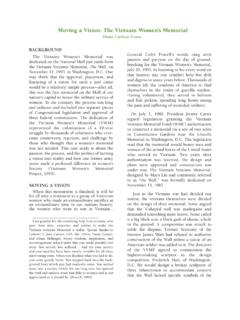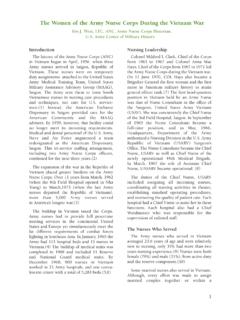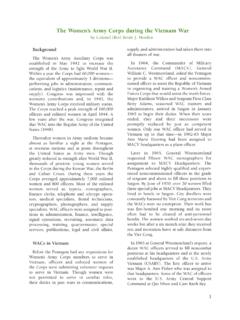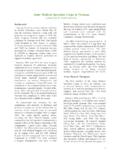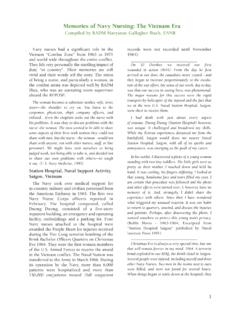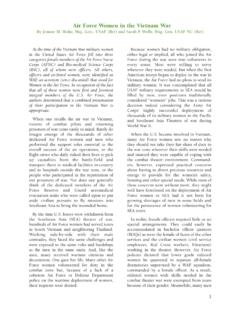Transcription of Women Marines in Vietnam
1 Companion to greater opportunity is greaterresponsibility and for Women in the MarineCorps in the 1960s that meant service in thewar torn Republic of Vietnam . The announce-ment was made and plans were set in 1967for one officer and nine enlisted Women to fill desk billets with the Military AssistanceCommand, Vietnam (MACV), based in , they were to work with the MarineCorps Personnel Section on the staff of theCommander, Naval forces, Vietnam . The section provided administrative support toMarines assigned as far north as theDemilitarized Zone (DMZ). Later, another officer billet was added and LieutenantColonels Ruth J. O Holleran and Ruth eventually served as historians withthe Military History Branch, Secretary JointStaff, was taken to select mature, stable WMswho could be expected to adapt to strange surroundings and cope in an Women Marines were asked to volunteer by notifying their commandingofficer or by indicating their desire to serve inVietnam on their fitness reports.
2 There was noshortage of volunteers, but not all met the criteria. Then there were a number of womenwho would willingly accept, but not volunteerfor orders to a combat zone. Theoretically, allWMs who served in Vietnam were volunteersin that nearly all had expressed their willing-ness to go and none objected. When MasterSergeant Bridget V. Connolly was asked whatmade her volunteer for duty in Saigon, shelaughed and said, Who volunteered? Ireceived my orders in the guard mail. Shebecame a legitimate volunteer when her initialtour ended and she extended for an additionalsix first woman Marine to report to Vietnamfor duty was Master Sergeant Barbara , who arrived on 18 March 1967. Afteran 18-hour flight, she landed at dusk at BienHoa, about 30 miles north of Saigon. Travelwas restricted after dark on the unsecure roads,so she was billeted overnight at the next morning she was taken by bus andarmed escort to Koeppler Compound in Saigonand there her tour began with a security lecture.
3 The briefing was not concerned withsecurity of classified material as one mightexpect, but with security in day-to-day living inVietnam, such as recognizing booby traps, andchecking cabs upon entering to ensure therewas a handle inside. Arrival procedures weresimilar for most first, the enlisted Women were quarteredin the Ambassador Hotel, and later they movedto the Plaza, a hotel-dormitory, two to a of other services and several hundredmen called the Plaza home. By spring 1968, the enlisted Women were moved to the Billings Bachelor Enlisted Quarters (BEQ),located near MACV Headquarters and Tan SonNhut , the Women officers were billetedin Le Qui Don, a hotel-like Bachelor OfficersQuarters (BOQ). Company grade of officerswere usually assigned two to a room; WMs andWAVES billeted together. Like the Plaza andBillings BEQ, Le Qui Don Hotel was air condi-tioned, but electricity was a sometime were no eating facilities in either theBillings BEQ or the Le Qui Don BOQ.
4 Most ofthe Women cooked in their room on hot platesor with electric skillets. When the power wasout, they managed with charcoal-grilled mealsserved by were no laundry facilities, but forabout $15 a month, each woman hired a maidwho cleaned her room and washed and pressedher uniforms. Before leaving the United Statesthe Women Marines were cautioned to bring anample supply of nylons, sturdy cotton lingerie,and summer uniforms. Not only were theseitems scarce in the post exchange that cateredto male troops, but the maids were unduly hardon them. Lieutenant Colonel Elaine E. FilkinsWomen Marines in VietnamColonel Mary V. Stremlow, Marine Corps Reserve, Retired1(later Davies) spoke of looking out her windowto see the maid laundering her nylon stockingsand lingerie in a creek by pounding them withrocks. The garments that survived were a massof torn, short elastic threads. Girdles and braswere short lived in the combat zone .Nylon hosiery was luxury.
5 Women of someservices were even excused from wearing themwhen in uniform, a privilege not extended towomen Marines . Vietnamese Women were fascinated by the sheer stockings andLieutenant Colonel Vera M. Jones told of walking down the streets of Saigon and beingstartled by the touch of a Vietnamese womanfeeling her Women were advised to arrive with fourto six pairs of dress pumps for uniform wear because the streets were hard on shoes and repair service was unsatisfactory. Inthe Information on Saigon booklet providedeach woman before leaving the United Statewas written, ..bring a dozen sets of Heels can easily be extracted with a pair of pliers and new ones inserted with little difficulty. For the most part the WMs worked inSaigon, but on occasion duty took them outside the city. In January 1969, CaptainFilkins, in a letter to the Director of WomenMarines, wrote: In early December, Corporal Spaatz and I traveledto Da Nang with nearly 100 SRB/OQRs (service recordbooks /officer qualification records) to conduct an auditof the service records of the men stationed in the Army I Corps had been most kind in aiding us inour efforts to provide administrative assistance to ourwidely scattered men.
6 Corporal Spaatz is a fine repre-sentative for the WMs with her professional handlingof the audit. It was obvious that the men enjoyed theunfamiliar click of the female high heeled shoes. Theweather was on our side so were able to wear the dresswith pumps the entire visit. When the weather was unusually wet orwhen the city was under attack, the womenwore utilities and oxfords. In addition theArmy issued field uniforms, oxfords, and combat boots to any woman required to wearthem for Tet offensive of January-February 1968,a large scale enemy attack that disrupted thecity, brought some changes to the lives of WMsin Saigon. At the time enlisted Women werestill quartered at the Plaza which received auto-matic weapons fire. Bus service to many of theBOWs and BEWs was cut off, confining thewomen to their Jones was unable to leave the Le QuiDon for a day and a half before bus service,with armed escorts, resumed.
7 Excerpts of a letter from Captain Jones to Colonel Bishoptold something of the situation:3 February 1968. It s hard to believe that awar is going on around me. I sit here calmlytyping this letter and yet can get up, walk to awindow, and watch the helicopters makingmachine gun and rocket strikes in the area ofthe golf course which is about three blocksaway. At night, I lie in bed and listen to themortar rounds going off. The streets, which arenormally crowded with traffic, are MSgt Dulinsky, Cpl Hensley, and CplWilson finally got into work this Hensley and Wilson plan to spend from a letter from Master SergeantDulinsky elaborated: 9 February 1968. We are still on a 24-hour curfew,with all hands in personnel (Womenincluded) were bussed down to Koeppler compound and issued 3 pair of jungle fatigues and a pair of jungle now, most of us don t look the picture of the NewImage.
8 Whew! Hardly! I can t determine at night, if I mpooped from the work day or from carrying around theseanvils tied to my feet called combat Young-uns (and me too inside) were scared, 2but you d have been proud of them. They turned to in the mess, cashiering, washing dishes, serving and clearing tables. Although the Tet offensive kept the womenfrom attending the celebration of the silveranniversary of the Women Marines in Okinawa,they were not without a celebration. Thanks to a WAVE and male Marines , they had a cake in the office and the traditional cakecutting command expected each person to work60 productive hours a week. Time off was precious, and recreational facilities were limit-ed. Bowling was a popular sport, and oldAmerican television shows were broadcast afew hours each evening. The city was oftenunder curfew with the Americans back in their quarters by 2000 or 2200.
9 Movies were available several nights a week in some ofthe BEQs and BOQs. A number of the womenkept busy during their off-duty hours by work-ing at the Armed Forces Television Station,helping at various orphanages, and visitingVietnamese families. Captain Jones, the onlywoman Marine who attended Vietnamese language school, taught English to a class ofVietnamese Filkins, interested in an orphanagefor blind girls, solicited soap, clothing, linens,toys, and supplies from the Women Marinecompanies at home. In her letter she wrote, They are rather confined in their small, dark world ofthe orphanage so they seem quite thrilled when visitorscome to see of these children are lucky if they are picked up and held for a few minutes each week. One woman Marine in particular, StaffSergeant Ermelinda Salazar (later Esquibel),who touched the lives of Vietnameseorphans, was nominated for the 1970 Unsung Heroine Award sponsored by theVeterans of Foreign Wars Auxiliary, and wasimmortalized in a painting by Marine artistCliff Yound.
10 During her 15 months inAdigon, Staff Sergeant Salazar essentiallytook over a MACV civic action projectinvolving the St. Vincent de Paul a letter dated 10 September 1969, toGunnery Sergeant Helen a Dowd, she told ofher work with the children: I don t remember if I mentioned to you that I had been working with the orphanage supported by MACV. It is not a big one - only 75 children agesfrom a few weeks old to about 11 or 12 years of are precious and quite wholeorphanage is taken care of by two Catholic sisters ..One of them is rather advanced in age (aboutin her 60 s) and the other is quite young and and all, Gunny, these two souls work themselvesto two sisters are Vietnamese who speakno English at me? I know a limited numberof broken phrases and words in I ve been working at the orphanage. I ve had toovercome much repugnance.
